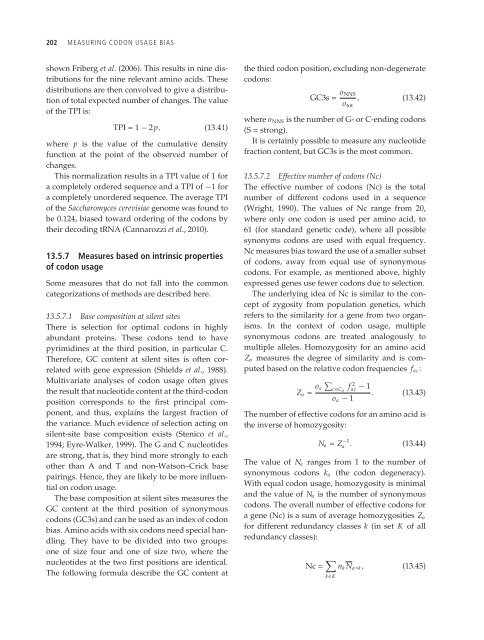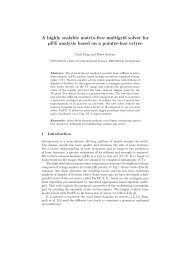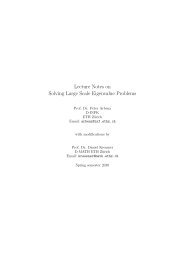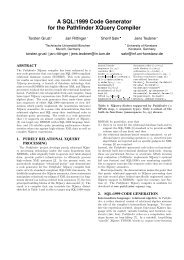Codon Evolution Mechanisms and Models
Codon Evolution Mechanisms and Models
Codon Evolution Mechanisms and Models
You also want an ePaper? Increase the reach of your titles
YUMPU automatically turns print PDFs into web optimized ePapers that Google loves.
202 MEASURING CODON USAGE BIAS<br />
shown Friberg et al. (2006). This results in nine distributions<br />
for the nine relevant amino acids. These<br />
distributions are then convolved to give a distribution<br />
of total expected number of changes. The value<br />
of the TPI is:<br />
TPI=1− 2p, (13.41)<br />
where p is the value of the cumulative density<br />
function at the point of the observed number of<br />
changes.<br />
This normalization results in a TPI value of 1 for<br />
a completely ordered sequence <strong>and</strong> a TPI of −1 for<br />
a completely unordered sequence. The average TPI<br />
of the Saccharomyces cerevisiae genome was found to<br />
be 0.124, biased toward ordering of the codons by<br />
their decoding tRNA (Cannarozzi et al., 2010).<br />
13.5.7 Measures based on intrinsic properties<br />
of codon usage<br />
Some measures that do not fall into the common<br />
categorizations of methods are described here.<br />
13.5.7.1 Base composition at silent sites<br />
There is selection for optimal codons in highly<br />
abundant proteins. These codons tend to have<br />
pyrimidines at the third position, in particular C.<br />
Therefore, GC content at silent sites is often correlated<br />
with gene expression (Shields et al., 1988).<br />
Multivariate analyses of codon usage often gives<br />
the result that nucleotide content at the third-codon<br />
position corresponds to the first principal component,<br />
<strong>and</strong> thus, explains the largest fraction of<br />
the variance. Much evidence of selection acting on<br />
silent-site base composition exists (Stenico et al.,<br />
1994; Eyre-Walker, 1999). The G <strong>and</strong> C nucleotides<br />
are strong, that is, they bind more strongly to each<br />
other than A <strong>and</strong> T <strong>and</strong> non-Watson–Crick base<br />
pairings. Hence, they are likely to be more influential<br />
on codon usage.<br />
The base composition at silent sites measures the<br />
GC content at the third position of synonymous<br />
codons (GC3s) <strong>and</strong> can be used as an index of codon<br />
bias. Amino acids with six codons need special h<strong>and</strong>ling.<br />
They have to be divided into two groups:<br />
one of size four <strong>and</strong> one of size two, where the<br />
nucleotides at the two first positions are identical.<br />
The following formula describe the GC content at<br />
the third codon position, excluding non-degenerate<br />
codons:<br />
GC3s = oNNS<br />
, (13.42)<br />
otot<br />
where oNNS is the number of G- or C-ending codons<br />
(S = strong).<br />
It is certainly possible to measure any nucleotide<br />
fraction content, but GC3s is the most common.<br />
13.5.7.2 Effective number of codons (Nc)<br />
The effective number of codons (Nc) is the total<br />
number of different codons used in a sequence<br />
(Wright, 1990). The values of Nc range from 20,<br />
where only one codon is used per amino acid, to<br />
61 (for st<strong>and</strong>ard genetic code), where all possible<br />
synonyms codons are used with equal frequency.<br />
Nc measures bias toward the use of a smaller subset<br />
of codons, away from equal use of synonymous<br />
codons. For example, as mentioned above, highly<br />
expressed genes use fewer codons due to selection.<br />
The underlying idea of Nc is similar to the concept<br />
of zygosity from population genetics, which<br />
refers to the similarity for a gene from two organisms.<br />
In the context of codon usage, multiple<br />
synonymous codons are treated analogously to<br />
multiple alleles. Homozygosity for an amino acid<br />
Za measures the degree of similarity <strong>and</strong> is computed<br />
based on the relative codon frequencies fac:<br />
Za = oa<br />
� 2 f c∈Ca ac − 1<br />
. (13.43)<br />
oa − 1<br />
The number of effective codons for an amino acid is<br />
the inverse of homozygosity:<br />
Na = Z −1<br />
a . (13.44)<br />
The value of Na ranges from 1 to the number of<br />
synonymous codons ka (the codon degeneracy).<br />
With equal codon usage, homozygosity is minimal<br />
<strong>and</strong> the value of Na is the number of synonymous<br />
codons. The overall number of effective codons for<br />
a gene (Nc) is a sum of average homozygosities Za<br />
for different redundancy classes k (in set K of all<br />
redundancy classes):<br />
Nc = �<br />
k∈K<br />
nk Na=k, (13.45)









